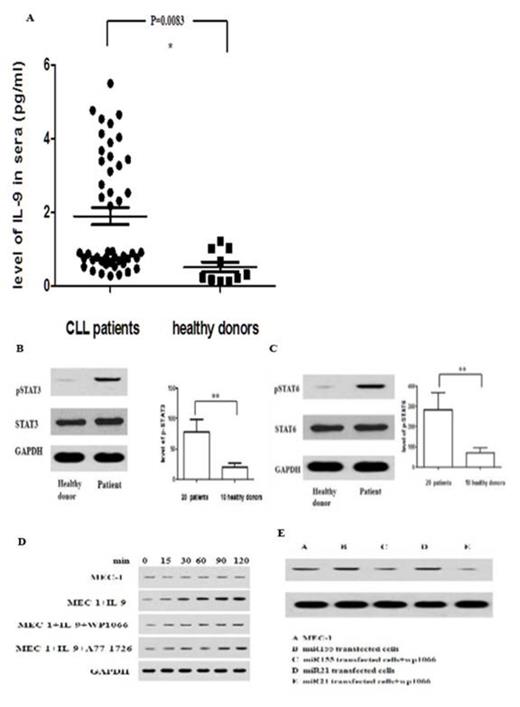Abstract
Chronic lymphocytic leukemia (CLL) is a common leukemia in adults, but its pathogenesis is still poorly understood. Interleukin-9(IL-9) has pleiotropic functions in hematological malignancies. Phosphorylation (p) of signal transducer and activator of transcription (STAT) occurs in hematologic malignancies, including STAT3 and STAT6. Studies from cell culture and animal models have revealed that the Janus kinase-signal transducer and activator of transcription (Jak-STAT) signaling pathway, which can be activated by sorts of cytokines involved IL-9. Circulating microRNAs(miRNAs) can be sensitive biomarkers for CLL and STAT3 stimulation induced miR-155 and miR-21 upregulation in CLL cells.
The expressions of IL-9, pSTAT3, pSTAT6, miR-155 and miR-21 were detected in CLL patients. We strived to prove that STAT3 and STAT6 phosphorylation may play a key regulating role in the secretion of IL-9, which may affect the proliferation and apoptosis of CLL cells. We also examined whether the overexpressions of miR155 and miR21 genes promote IL-9 production and STAT3 affects the transcription of miR155 and miR21 in CLL cells.
We measured serum levels of IL-9 in 47 patients with CLL and healthy controls using ELISA. Expressions of pSTAT3 and pSTAT6 were evaluated by Western blot in peripheral blood mononuclear cells (PBMCs) from 20 CLL patients with upregulation of IL-9 and B cells from healthy samples. Analyses of miRNA155 and miRNA21 expressions were conducted on 20 patient samples and healthy samples through qPCR. IL-9 production was detected by Western blot and qPCR in both IL-9 stimulated CLL cells (MEC-1) and miR-transfected MEC-1 cells at different time point. And then the IL-9 secreting was detected after these cells exposed to WP1066 or A77-1726 for 48 hours. Finally, we observed that cell proliferation with CCK-8 incorporation assay and cell apoptosis using AnnexinV-FITC/PI staining followed by flow cytometry.
An elevated serum level of IL-9 was detected in 20 of 47 sera from CLL patients (Figure 1A). Sera IL-9 level was correlated with the clinical staging, ZAP-70 expression, B2M expression and IgVH status of CLL patients. (P<0.05,Table 1). Overexpressions of pSTAT3, pSTAT6 in protein levels were detected in 20 CLL patients with upredulation of IL-9(Figure 1B-C), while expressions of miRNA 155 and miRNA21 were elevated in 20 CLL patients. The tyrosine STAT3 and STAT6 phosphorylation in MEC-1 cells stimulated by 20ng/mL IL-9 with time course was associated with an increase of the IL-9 secreting with time dependence. MEC-1 cells stimulated with IL-9 by a time course followed by treatment of Wp1066 (10ng/mL) and A77-1726(10ng/mL) eliminated the IL-9 secreting (Figure 1D). IL-9 protein levels were increased in miR-155 transfected MEC-1 cells and miR21 transfected MEC-1 cells treated with 10ng/mL IL-9 at 120min compared with untransfected cells. However Wp1066 could inhibit these facts (Figure 1E). The MEC-1 apoptoses inhibited and the proliferation enhanced by IL-9(20ng/ml) could be blocked by Wp1066 and A77-1726 (Figure 2A-B). MEC-1 cells transfected with miR-155 and miR21 could promote all these effects of IL-9, which inhibited by Wp1066 (Figure 2C-D).
| Characteristic . | IL-9 Expression . | P value . | |
|---|---|---|---|
| . | Positive(%) . | Negative(%) . | |
| Sex | |||
| Male | 14(70.0) | 19(70.4) | 0.6580 |
| Female | 6(30.0) | 8(29.6) | |
| Age(yr) | |||
| Younger than 60 | 7(35.0) | 12(44.4) | 0.4063 |
| Older than 60 | 13(65.0) | 15(55.6) | |
| ZAP-70 expression | |||
| Positive | 4 | 0 | 0.0272* |
| Negative | 16 | 27 | |
| IgVH status | |||
| Unmutated (≥ 98% homology) | 14 | 26 | |
| Mutated (< 98% homology) | 6 | 1 | 0.0320* |
| B2M expression | |||
| No more than 4 mg/L | 15 | 27 | |
| more than 4 mg/L | 5 | 0 | 0.0101* |
| Rai classification | |||
| S1 | 1 | 6 | |
| S2 | 3 | 8 | |
| S3 | 5 | 11 | |
| S4 | 11 | 2 | 0.0035 |
| Binet classification | |||
| A | 3 | 13 | |
| B | 6 | 12 | |
| C | 11 | 2 | 0.0010 |
| Characteristic . | IL-9 Expression . | P value . | |
|---|---|---|---|
| . | Positive(%) . | Negative(%) . | |
| Sex | |||
| Male | 14(70.0) | 19(70.4) | 0.6580 |
| Female | 6(30.0) | 8(29.6) | |
| Age(yr) | |||
| Younger than 60 | 7(35.0) | 12(44.4) | 0.4063 |
| Older than 60 | 13(65.0) | 15(55.6) | |
| ZAP-70 expression | |||
| Positive | 4 | 0 | 0.0272* |
| Negative | 16 | 27 | |
| IgVH status | |||
| Unmutated (≥ 98% homology) | 14 | 26 | |
| Mutated (< 98% homology) | 6 | 1 | 0.0320* |
| B2M expression | |||
| No more than 4 mg/L | 15 | 27 | |
| more than 4 mg/L | 5 | 0 | 0.0101* |
| Rai classification | |||
| S1 | 1 | 6 | |
| S2 | 3 | 8 | |
| S3 | 5 | 11 | |
| S4 | 11 | 2 | 0.0035 |
| Binet classification | |||
| A | 3 | 13 | |
| B | 6 | 12 | |
| C | 11 | 2 | 0.0010 |
Fisher's exact test
Our findings suggest that a new explanation about the possible molecular mechanism of regulation of IL-9 production in CLL. It may provide useful insights in understanding the cross-talking pathways among IL-9, STAT3, STAT6, miR-155 and miR-21, which promote the pathogenesis of CLL.
No relevant conflicts of interest to declare.
Author notes
Asterisk with author names denotes non-ASH members.



This feature is available to Subscribers Only
Sign In or Create an Account Close Modal